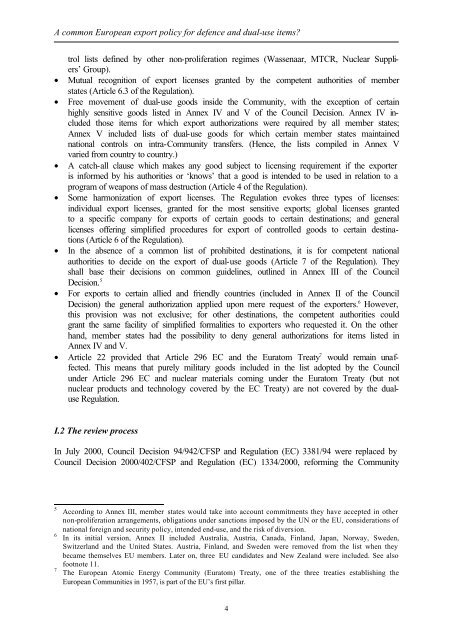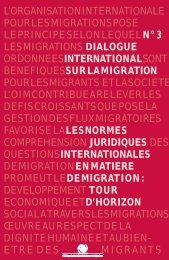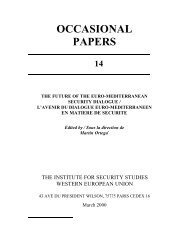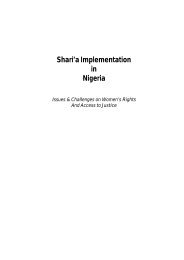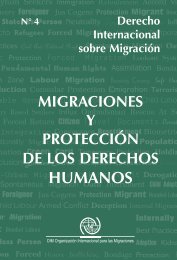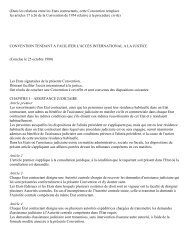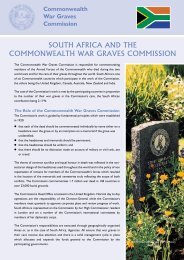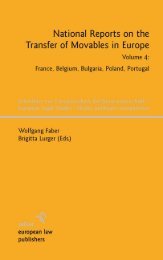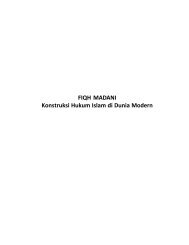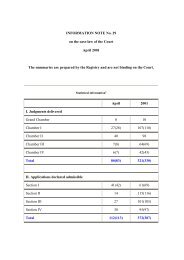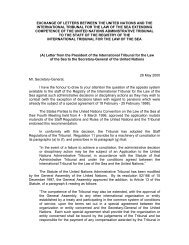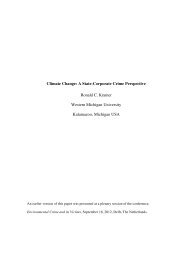A common European export policy for defence and dual-use items?
A common European export policy for defence and dual-use items?
A common European export policy for defence and dual-use items?
Create successful ePaper yourself
Turn your PDF publications into a flip-book with our unique Google optimized e-Paper software.
A <strong>common</strong> <strong>European</strong> <strong>export</strong> <strong>policy</strong> <strong>for</strong> <strong>defence</strong> <strong>and</strong> <strong>dual</strong>-<strong>use</strong> <strong>items</strong>?<br />
trol lists defined by other non-proliferation regimes (Wassenaar, MTCR, Nuclear Suppliers’<br />
Group).<br />
• Mutual recognition of <strong>export</strong> licenses granted by the competent authorities of member<br />
states (Article 6.3 of the Regulation).<br />
• Free movement of <strong>dual</strong>-<strong>use</strong> goods inside the Community, with the exception of certain<br />
highly sensitive goods listed in Annex IV <strong>and</strong> V of the Council Decision. Annex IV included<br />
those <strong>items</strong> <strong>for</strong> which <strong>export</strong> authorizations were required by all member states;<br />
Annex V included lists of <strong>dual</strong>-<strong>use</strong> goods <strong>for</strong> which certain member states maintained<br />
national controls on intra-Community transfers. (Hence, the lists compiled in Annex V<br />
varied from country to country.)<br />
• A catch-all cla<strong>use</strong> which makes any good subject to licensing requirement if the <strong>export</strong>er<br />
is in<strong>for</strong>med by his authorities or ‘knows’ that a good is intended to be <strong>use</strong>d in relation to a<br />
program of weapons of mass destruction (Article 4 of the Regulation).<br />
• Some harmonization of <strong>export</strong> licenses. The Regulation evokes three types of licenses:<br />
indivi<strong>dual</strong> <strong>export</strong> licenses, granted <strong>for</strong> the most sensitive <strong>export</strong>s; global licenses granted<br />
to a specific company <strong>for</strong> <strong>export</strong>s of certain goods to certain destinations; <strong>and</strong> general<br />
licenses offering simplified procedures <strong>for</strong> <strong>export</strong> of controlled goods to certain destinations<br />
(Article 6 of the Regulation).<br />
• In the absence of a <strong>common</strong> list of prohibited destinations, it is <strong>for</strong> competent national<br />
authorities to decide on the <strong>export</strong> of <strong>dual</strong>-<strong>use</strong> goods (Article 7 of the Regulation). They<br />
shall base their decisions on <strong>common</strong> guidelines, outlined in Annex III of the Council<br />
Decision. 5<br />
• For <strong>export</strong>s to certain allied <strong>and</strong> friendly countries (included in Annex II of the Council<br />
Decision) the general authorization applied upon mere request of the <strong>export</strong>ers. 6 However,<br />
this provision was not exclusive; <strong>for</strong> other destinations, the competent authorities could<br />
grant the same facility of simplified <strong>for</strong>malities to <strong>export</strong>ers who requested it. On the other<br />
h<strong>and</strong>, member states had the possibility to deny general authorizations <strong>for</strong> <strong>items</strong> listed in<br />
Annex IV <strong>and</strong> V.<br />
• Article 22 provided that Article 296 EC <strong>and</strong> the Euratom Treaty 7 would remain unaffected.<br />
This means that purely military goods included in the list adopted by the Council<br />
under Article 296 EC <strong>and</strong> nuclear materials coming under the Euratom Treaty (but not<br />
nuclear products <strong>and</strong> technology covered by the EC Treaty) are not covered by the <strong>dual</strong><strong>use</strong><br />
Regulation.<br />
I.2 The review process<br />
In July 2000, Council Decision 94/942/CFSP <strong>and</strong> Regulation (EC) 3381/94 were replaced by<br />
Council Decision 2000/402/CFSP <strong>and</strong> Regulation (EC) 1334/2000, re<strong>for</strong>ming the Community<br />
5<br />
6<br />
7<br />
According to Annex III, member states would take into account commitments they have accepted in other<br />
non-proliferation arrangements, obligations under sanctions imposed by the UN or the EU, considerations of<br />
national <strong>for</strong>eign <strong>and</strong> security <strong>policy</strong>, intended end-<strong>use</strong>, <strong>and</strong> the risk of diversion.<br />
In its initial version, Annex II included Australia, Austria, Canada, Finl<strong>and</strong>, Japan, Norway, Sweden,<br />
Switzerl<strong>and</strong> <strong>and</strong> the United States. Austria, Finl<strong>and</strong>, <strong>and</strong> Sweden were removed from the list when they<br />
became themselves EU members. Later on, three EU c<strong>and</strong>idates <strong>and</strong> New Zeal<strong>and</strong> were included. See also<br />
footnote 11.<br />
The <strong>European</strong> Atomic Energy Community (Euratom) Treaty, one of the three treaties establishing the<br />
<strong>European</strong> Communities in 1957, is part of the EU’s first pillar.<br />
4


